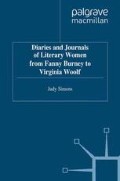Abstract
In the eighteenth century when women as a group first began to make their mark on the literary scene, they adopted certain tactics and topics that helped to insulate them as a sex against overt criticism of their effrontery at daring to publish at all. They focused their attention on the subjects they were supposed to know best, on domestic life, with female characters and female conduct the object of their moral concern. Poems and novels by women could safely take love as their theme without being thought to poach on the male preserves of power politics or trenchant social criticism, and romance consequently figured as a major motif in these texts. Over the next two hundred years, as women established for themselves a distinctive place in literary history, these topics remained dominant in their work, appealing to a growing mass market of bourgeois literate women readers who found in women’s writing reflections of the fabric and the fantasies of their own lives.
There is hardly an example of a diary written out of a first-class creative mind.
—P. A. Spalding. Self-Harvest: A Study of Diaries and the Diarist, p. 12
Access this chapter
Tax calculation will be finalised at checkout
Purchases are for personal use only
Preview
Unable to display preview. Download preview PDF.
Notes
April 1869, Ednah D. Cheyney (ed.), Louisa May Alcott: Her Life, Letters and Journals ( London: Sampson Low, Marston; Searle & Rivington, 1889 ) p. 202.
George Eliot, Journal in Gordon S. Haight, George Eliot ( Harmondsworth: Penguin, 1985 ) pp. 351–78.
Oct. 1920, in C. K. Stead (ed.), Katherine Mansfield, Letters and Journals ( Harmondsworth: Penguin, 1985 ) p. 183.
The Diary of Anais Nin, quoted in Joanna Russ, How to Suppress Women’s Writing ( London: Women’s Press, 1984 ) p. 102.
Author information
Authors and Affiliations
Copyright information
© 1990 Judy Simons
About this chapter
Cite this chapter
Simons, J. (1990). Conclusion. In: Diaries and Journals of Literary Women from Fanny Burney to Virginia Woolf. Palgrave Macmillan, London. https://doi.org/10.1057/9780230376441_10
Download citation
DOI: https://doi.org/10.1057/9780230376441_10
Publisher Name: Palgrave Macmillan, London
Print ISBN: 978-0-333-52341-4
Online ISBN: 978-0-230-37644-1
eBook Packages: Palgrave Literature & Performing Arts CollectionLiterature, Cultural and Media Studies (R0)

